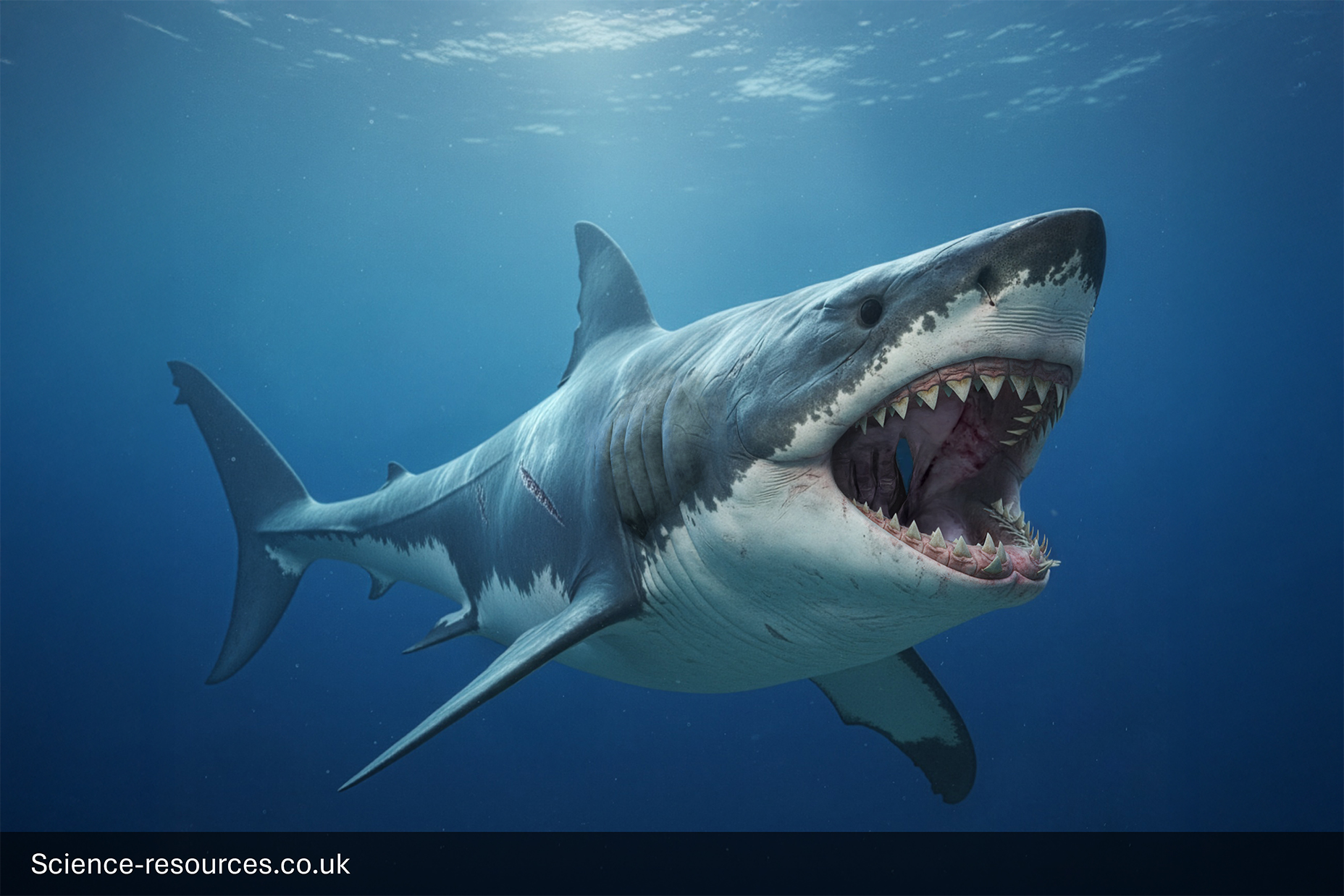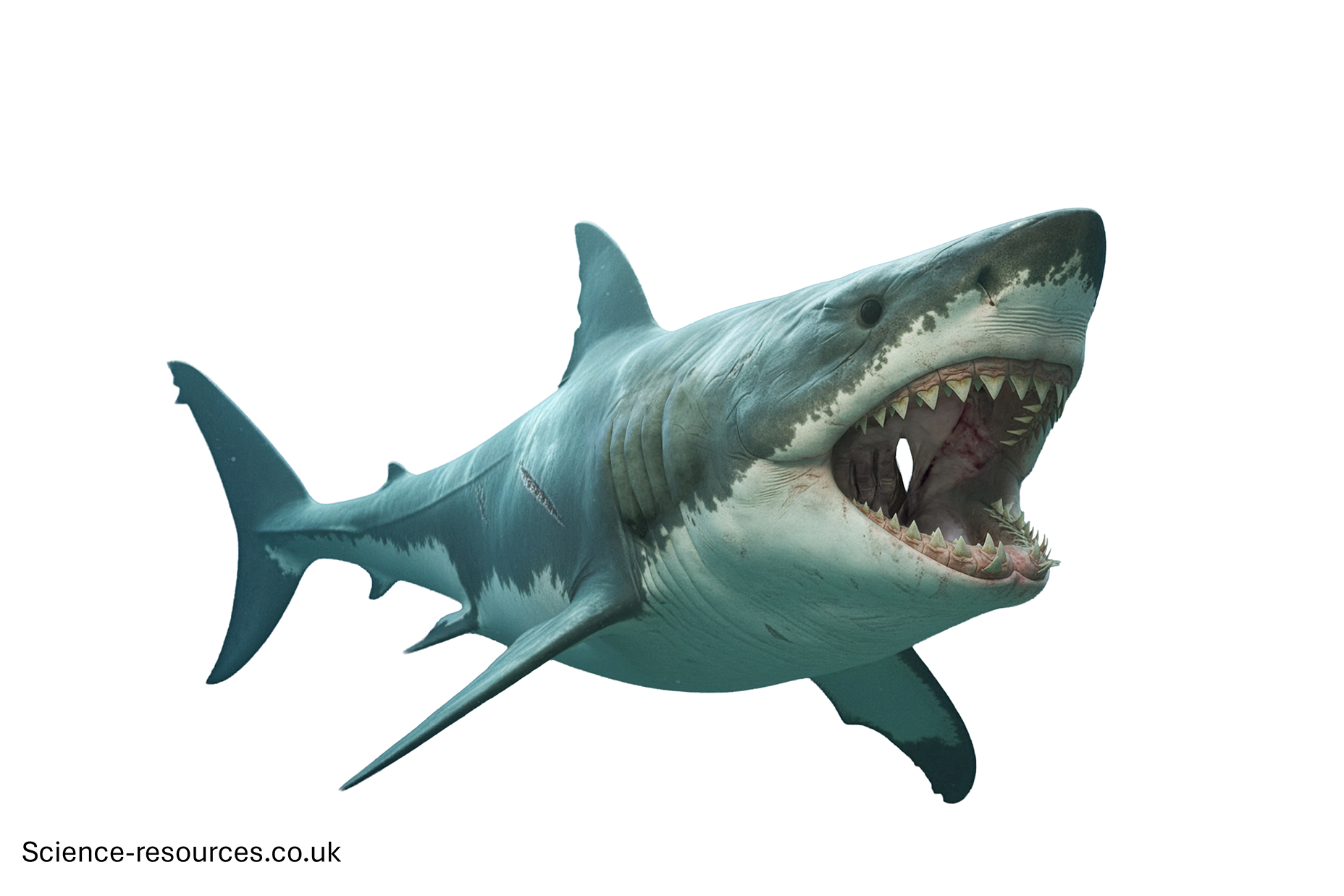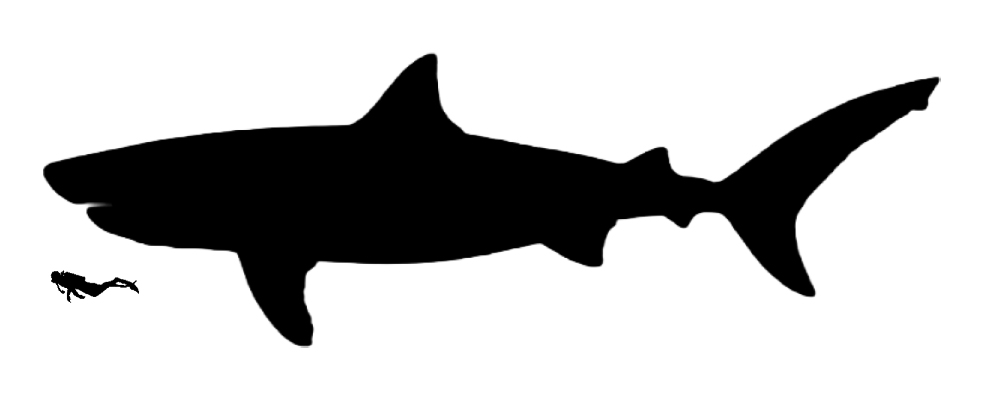Last updated: 4th August 2025
Extinct Animals: Megalodon
Megalodon, an extinct, colossal, shark species that once dominated ancient oceans with its massive jaws.
Megalodon (Big Tooth)
 Megalodon
Megalodon
Generative AI Notification: Some elements of this image have been created or enhanced using AI technology. To find out how we create all our prehistoric animals, click here.
What is Megalodon?
Megalodon was a colossal species of prehistoric shark that ruled the world’s oceans millions of years ago. It is one of the largest and most powerful predators to have ever lived.
How big was Megalodon?
Megalodon could grow up to 16–18 metres (52–59 feet) long—about three times the length of a great white shark. It may have weighed up to 50–70 tonnes.
What did Megalodon eat?
Megalodon was a carnivore, preying on whales, dolphins, seals, and large fish. Its enormous jaws were filled with rows of sharp, serrated teeth for biting through bone and flesh.
Megalodon appearance
Megalodon looked similar to a supersized great white shark, with a bulky, torpedo-shaped body and a massive mouth lined with teeth up to 18 centimetres (7 inches) long.
 Megalodon appearance
Megalodon appearance
Where did Megalodon live?
Fossils of Megalodon teeth have been found all over the world, from Europe and Africa to the Americas, Australia, and Asia. It lived in warm, coastal waters.
Interesting facts
- Its bite was so powerful it could crush a car in a single chomp!
- Megalodon means "Big Tooth" in Greek.
- One Megalodon tooth can be bigger than a human hand.
- Despite what some films suggest, Megalodon is definitely extinct.

Megalodon Facts
Pronounced: MEG-ah-lo-don
Name Means: "Big Tooth"
Length: Up to 18 metres (59 feet)
Weight: Up to 70,000 kilograms (70 tonnes)
Diet: Carnivore (meat-eater)
Time: Miocene to Pliocene Epochs (about 23 to 3.6 million years ago)
Fossils Found: Worldwide (all continents except Antarctica)
Which family of animals did Megalodon belong to?
Megalodon belonged to the family Otodontidae, a group of giant prehistoric sharks. It is not a direct ancestor of the great white shark, but they are distant relatives.
What other animals lived at the same time as Megalodon?
Megalodon shared its oceans with ancient whales, like Livyatan, giant sea turtles, early dolphins, and other prehistoric sharks during the Miocene and Pliocene epochs.
Megalodon FAQ
Q1: What was Megalodon?
A1: Megalodon is an extinct species of giant shark that lived millions of years ago. It was the top predator in the ancient oceans.
Q2: What did Megalodon look like?
A2: Megalodon looked like a giant great white shark, but much bulkier and with teeth up to three times the size.
Q3: How big was Megalodon?
A3: It could reach up to 18 metres (59 feet) in length and weighed up to 70 tonnes.
Q4: What did Megalodon eat?
A4: Megalodon hunted large marine animals like whales, dolphins, and large fish.
Q5: Where did Megalodon live?
A5: It lived in warm, coastal seas all around the world.
Q6: When did Megalodon go extinct?
A6: Megalodon went extinct about 3.6 million years ago, likely due to changes in climate, falling sea levels, and the disappearance of its main prey.
Q7: How strong was Megalodon’s bite?
A7: Its bite force is estimated at up to 180,000 newtons—strong enough to crush bones and even car doors!
Q8: How is Megalodon related to modern animals?
A8: Megalodon is distantly related to modern sharks, but not the direct ancestor of the great white shark.
Q9: Who discovered Megalodon?
A9: Fossilised Megalodon teeth have been found for centuries, but the species was first scientifically described in the 19th century.
Q10: Are there any complete skeletons of Megalodon?
A10: No, only teeth and a few vertebrae have been found, because shark skeletons are made of cartilage, which doesn’t fossilise well.
You may also be intrested in:
- Extinct Animals: A-Z
- Dinosaurs: A-Z
Tags: How big was Megalodon, Megalodon size, where did Megalodon live, how long was Megalodon, what does Megalodon mean, Megalodon facts
Previous: Megaloceros
Up next: Megatherium
© 2012 science-resources.co.uk. All rights reserved | Design by W3layouts
Extinct Animals: Megalodon
Megalodon, an extinct, colossal, shark species that once dominated ancient oceans with its massive jaws.
Megalodon (Big Tooth)
 Megalodon
Megalodon
Generative AI Notification: Some elements of this image have been created or enhanced using AI technology. To find out how we create all our prehistoric animals, click here.
What is Megalodon?
Megalodon was a colossal species of prehistoric shark that ruled the world’s oceans millions of years ago. It is one of the largest and most powerful predators to have ever lived.
How big was Megalodon?
Megalodon could grow up to 16–18 metres (52–59 feet) long—about three times the length of a great white shark. It may have weighed up to 50–70 tonnes.
What did Megalodon eat?
Megalodon was a carnivore, preying on whales, dolphins, seals, and large fish. Its enormous jaws were filled with rows of sharp, serrated teeth for biting through bone and flesh.
Megalodon appearance
Megalodon looked similar to a supersized great white shark, with a bulky, torpedo-shaped body and a massive mouth lined with teeth up to 18 centimetres (7 inches) long.
 Megalodon appearance
Megalodon appearance
Where did Megalodon live?
Fossils of Megalodon teeth have been found all over the world, from Europe and Africa to the Americas, Australia, and Asia. It lived in warm, coastal waters.
Interesting facts
- Its bite was so powerful it could crush a car in a single chomp!
- Megalodon means "Big Tooth" in Greek.
- One Megalodon tooth can be bigger than a human hand.
- Despite what some films suggest, Megalodon is definitely extinct.

Megalodon Facts
Pronounced: MEG-ah-lo-don
Name Means: "Big Tooth"
Length: Up to 18 metres (59 feet)
Weight: Up to 70,000 kilograms (70 tonnes)
Diet: Carnivore (meat-eater)
Time: Miocene to Pliocene Epochs (about 23 to 3.6 million years ago)
Fossils Found: Worldwide (all continents except Antarctica)
Which family of animals did Megalodon belong to?
Megalodon belonged to the family Otodontidae, a group of giant prehistoric sharks. It is not a direct ancestor of the great white shark, but they are distant relatives.
What other animals lived at the same time as Megalodon?
Megalodon shared its oceans with ancient whales, like Livyatan, giant sea turtles, early dolphins, and other prehistoric sharks during the Miocene and Pliocene epochs.
Megalodon FAQ
Q1: What was Megalodon?
A1: Megalodon is an extinct species of giant shark that lived millions of years ago. It was the top predator in the ancient oceans.
Q2: What did Megalodon look like?
A2: Megalodon looked like a giant great white shark, but much bulkier and with teeth up to three times the size.
Q3: How big was Megalodon?
A3: It could reach up to 18 metres (59 feet) in length and weighed up to 70 tonnes.
Q4: What did Megalodon eat?
A4: Megalodon hunted large marine animals like whales, dolphins, and large fish.
Q5: Where did Megalodon live?
A5: It lived in warm, coastal seas all around the world.
Q6: When did Megalodon go extinct?
A6: Megalodon went extinct about 3.6 million years ago, likely due to changes in climate, falling sea levels, and the disappearance of its main prey.
Q7: How strong was Megalodon’s bite?
A7: Its bite force is estimated at up to 180,000 newtons—strong enough to crush bones and even car doors!
Q8: How is Megalodon related to modern animals?
A8: Megalodon is distantly related to modern sharks, but not the direct ancestor of the great white shark.
Q9: Who discovered Megalodon?
A9: Fossilised Megalodon teeth have been found for centuries, but the species was first scientifically described in the 19th century.
Q10: Are there any complete skeletons of Megalodon?
A10: No, only teeth and a few vertebrae have been found, because shark skeletons are made of cartilage, which doesn’t fossilise well.
Tags: How big was Megalodon, Megalodon size, where did Megalodon live, how long was Megalodon, what does Megalodon mean, Megalodon facts
Previous: Megaloceros
Up next: Megatherium
© 2012 science-resources.co.uk. All rights reserved | Design by W3layouts